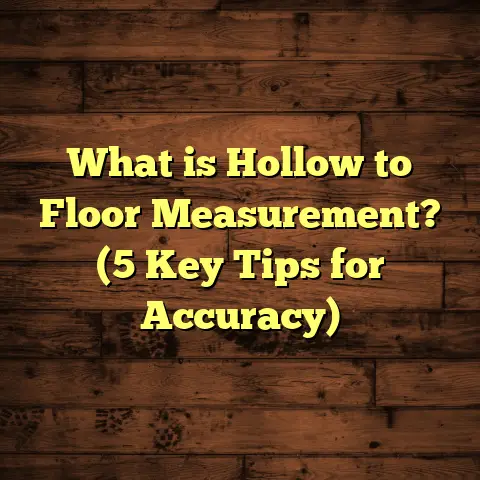What is Floor Area Ratio? (5 Key Factors Explained!)
Investing in real estate has always fascinated me—not just because of the potential financial gains but because of the many factors that shape how land and buildings can be utilized. One term I kept bumping into during my projects and discussions was Floor Area Ratio (FAR). I remember the first time I encountered it; I had no idea what it meant, but it quickly became a key piece in figuring out how much space I could build on a property. If you’re curious about how FAR works and why it matters in property investment and development, I’m glad to walk you through it.
What is Floor Area Ratio?
Floor Area Ratio, or FAR, is essentially a number that tells you how much floor space you can put on a piece of land relative to the size of that land. It’s a simple ratio but has a huge impact on building design, zoning regulations, and ultimately, the value of a property.
To break it down: FAR=Total floor area of all buildingsArea of the plot of land\text{FAR} = \frac{\text{Total floor area of all buildings}}{\text{Area of the plot of land}}
Say you have a 1,000 square meter lot and the local zoning code sets the FAR at 2. This means you could build up to 2,000 square meters of floor space on that lot. That 2,000 square meters could be spread over multiple floors or just one big floor—it depends on other zoning rules like height restrictions.
I first dealt with FAR when I helped a client in Chicago who wanted to develop a small apartment complex. The land was about 5,000 square feet, and the FAR was set to 3. It meant they could build up to 15,000 square feet of living space. Knowing this upfront prevented costly mistakes during design and planning stages.
Why Does FAR Matter So Much?
You might ask: why does this ratio really matter? From my experience, FAR is one of the first things I look at when evaluating any real estate opportunity. It’s like knowing the “rules of the game” before you start playing.
Knowing the FAR upfront tells you what kind of building you can create—whether it’s a sprawling single- story home or a multi-story commercial complex. It affects:
- How you design the building layout
- The number of units or rooms you can fit
- Your potential return on investment (ROI)
- The overall neighborhood density
For example, in dense urban areas where land is scarce and expensive, FAR tends to be higher to allow vertical building. In more suburban or rural locations, FAR is usually lower to preserve open space and reduce congestion.
A Personal Anecdote About FAR
Early in my career, I was consulting for a client who bought a small parcel in downtown Dallas. She was excited to build luxury condos but hadn’t checked the FAR limits before purchasing. Turns out, the FAR was capped at 1.5 for that district—much lower than she expected.
Because she hadn’t factored this in, her initial plans for a five-story building with spacious units were unfeasible. We had to go back to the drawing board and redesign a smaller building with fewer units. This experience taught me how crucial it is to understand local FAR before making big investments.
Key Factors That Affect Floor Area Ratio
Now, let me share the five main factors that influence FAR in any given location:
1. Zoning Regulations and Local Laws
Zoning laws are the biggest driver behind FAR limits.
These rules specify what type of buildings are allowed in different areas—residential, commercial, industrial—and dictate how large those buildings can be relative to their plot sizes.
For instance:
- A city might designate an area as residential with an FAR of 1.5.
- A commercial district nearby could allow FAR of 5 or above.
When I worked on a project in Dallas, the zoning laws required us to keep FAR under 2 for residential areas, but commercial zones nearby allowed FAR up to 6. Understanding these distinctions helped my client decide whether to build condos or retail space.
The process of obtaining zoning information can vary by city but generally involves checking municipal zoning maps and codes online or visiting city planning offices. For investors unfamiliar with local rules, I often recommend hiring zoning consultants early on.
Zoning and FAR Examples From Different Cities
I thought it would be helpful to share some real-world examples from cities I’ve worked in:
- New York City: Zoning districts here often have an FAR between 10 and 15 in dense commercial areas like Midtown Manhattan. Residential neighborhoods tend to range from 2 to 6.
- Los Angeles: Here, zoning varies dramatically by neighborhood. Downtown LA allows FARs as high as 15 in certain zones. However, beachside areas often cap FAR at under 1 to protect neighborhood character.
- Chicago: The city’s zoning code usually sets residential FARs around 2-4, with commercial areas allowing more dense development.
- Dallas: Many residential zones limit FAR between 0.5 and 2, while commercial corridors allow denser buildings with FARs up to 6.
Each city’s zoning approach reflects local priorities like population density goals, historic preservation, and infrastructure capacity.
2. Building Height Restrictions
FAR and height limits often go hand-in-hand but aren’t the same.
While FAR tells you total floor area allowed, height restrictions cap how tall your building can be. So even if your FAR allows for 10,000 square feet on a small lot, height caps might force you to spread that space out horizontally rather than vertically.
In San Francisco, for example, many neighborhoods limit buildings to around 40 feet tall (about 3-4 floors). This affects how the FAR is used because developers must design within those vertical limits.
In contrast, cities like Houston have fewer height restrictions, allowing for taller buildings if the FAR permits.
How Height Restrictions Affect Design Choices
I remember working with an architect who wanted to maximize floor space on a tight urban site in Boston. The FAR allowed plenty of floor area, but the height limit capped buildings at four stories. This forced us to design wider floor plates instead of going vertical.
That meant less natural light penetration into interior spaces, which affected the marketability of units. In that case, understanding both height limits and FAR helped us balance density with livability.
3. Lot Size and Shape
The size and shape of your land also influence how effectively you can use your FAR.
A regular-shaped plot (like square or rectangular) makes it easier to maximize floor area. Irregular plots might limit building layouts and reduce usable floor space even if the FAR is high.
I’ve encountered this several times when renovating older city blocks with oddly shaped parcels. Even though the zoning allowed decent FARs, actual buildable area was smaller due to setbacks and odd geometry.
For example: A narrow triangular lot might allow an FAR of 2 on paper but only fit a small footprint, meaning less practical floor area than expected.
Practical Example: Odd Lot Shapes
One project I consulted on involved an L-shaped lot in San Antonio. The zoning allowed an FAR of 3, but because part of the lot was unusable due to its shape and access constraints, we only managed to build floor space equivalent to an FAR of about 2.
This meant lower revenue potential than initially anticipated—another reminder that FAR is just one piece of the puzzle.
4. Setbacks and Open Space Requirements
Many municipalities require setbacks—the distance buildings must be from property lines—and open spaces like yards or plazas.
These rules effectively reduce the building footprint on your land, influencing how you use your permitted FAR.
For example, if your lot is 2,000 square meters with an FAR of 2 (allowing 4,000 square meters of floor area), but setbacks take away 500 square meters from buildable area, you’ll need to adjust design plans accordingly.
In Miami Beach, setbacks are strictly enforced due to hurricane concerns and aesthetic reasons, impacting how developers apply their FAR allowances.
How Setbacks Impact Construction Costs
Setbacks also influence foundation work and site preparation costs because they affect how much land remains for construction equipment and material storage.
On one project in Phoenix with strict front yard setbacks (20 ft minimum), staging materials offsite added about $15k extra compared to lots with no setback requirements.
5. Intended Use of the Building
The kind of building you plan affects how you approach FAR.
Residential buildings often have different requirements than commercial or mixed-use properties—for example:
- Parking minimums for residential complexes
- Loading zones for commercial spaces
- Common areas like lobbies or gyms
Each use affects how much floor area you can allocate for rentable or sellable space versus non-revenue parts of the building.
A client once asked me if they could build a high-rise hotel with an FAR of 8 on a downtown plot. We had to factor in large lobby spaces and back-of-house areas, so actual revenue-generating floor area was less than the maximum allowed by FAR alone.
How Floor Area Ratio Affects Property Value
Understanding how FAR impacts property value is critical if you want to make smart investments or develop land efficiently.
Higher FAR Usually Means Higher Land Value
Because higher FAR lets you build more floor space on the same plot, land with high allowable FAR tends to cost more per square foot than land with low allowable FAR.
For example:
| City | Typical Residential Land Price per Sq Ft | Typical Residential FAR | Price per Allowed Sq Ft (Land Price / FAR) |
|---|---|---|---|
| Manhattan NYC | $1,200 | 10 | $120 |
| Dallas Suburb | $120 | 1 | $120 |
| Los Angeles | $500 | 3 | $167 |
This table shows that when comparing land price adjusted by permitted density (FAR), Manhattan land is relatively cheaper per allowed square foot than Dallas land because Manhattan’s high demand supports tall buildings.
How Developers Use FAR For Profitability Calculations
I’ve seen developers calculate potential profit by estimating: Potential Revenue=Rentable Floor Area×Market Rent per Sq Ft\text{Potential Revenue} = \text{Rentable Floor Area} \times \text{Market Rent per Sq Ft}
Knowing allowable floor area from FAR sets the ceiling for rentable space. Then subtract design constraints like parking or open space requirements before estimating net revenue.
In Chicago, average commercial rent runs about $30 per sq ft annually. If your lot allows an FAR of 5 on a 10,000 sq ft site: Max Floor Area=50,000 sq ft\text{Max Floor Area} = 50,000 \text{ sq ft}
Estimated annual gross revenue: 50,000×$30=$1,500,00050,000 \times \$30 = \$1,500,000
Subtracting operating costs (~30%) leaves roughly $1 million net operating income—helping decide if buying that land makes financial sense.
Case Study: A Mixed-Use Development in Seattle
One project I worked on involved converting an old warehouse into mixed-use housing plus retail units downtown Seattle. The zoning allowed an FAR of 3.5 on a roughly 8,000 sq ft lot.
The plan included:
- Ground floor retail (3,000 sq ft)
- Three floors of residential units above (totaling ~25,000 sq ft)
By carefully analyzing setbacks and parking requirements (which took some floor area), we maximized usable space within the allowed FAR.
Construction cost estimates were about $250 per sq ft for mixed-use urban projects there at that time (2019). Total construction budget approached: 28,000×$250=$7 million28,000 \times \$250 = \$7 \text{ million}
The investment paid off well thanks partly to properly respecting FAR limits during planning—avoiding costly redesigns later.
Common Misconceptions About Floor Area Ratio
I’ve noticed several myths floating around about FAR that often confuse beginners:
- Myth: “FAR means the footprint size.”
- Reality: It means total floor area across all stories divided by lot size—not just footprint.
- Myth: “Higher FAR always means better investment.”
- Reality: Other factors like market demand and construction costs matter too.
- Myth: “FAR is fixed forever.”
- Reality: Local governments update zoning codes periodically—FAR can change.
- Myth: “FAR includes basements.”
- Reality: Some cities exclude below-grade floors; others count them differently.
Understanding these nuances saved me (and clients) from costly mistakes more than once!
Tools That Help Calculate and Visualize Floor Area Ratio
When managing projects involving FAR constraints, I rely on tools like FloorTally for budgeting flooring costs precisely based on actual floor areas determined by zoning limits and architectural plans.
Here’s why FloorTally helps:
- It accounts for waste factors—meaning you don’t order too much or too little material.
- Calculates labor costs based on local rates.
- Helps visualize total project cost linked directly with floor area data.
- Useful for both DIY enthusiasts and professional contractors like myself.
Using such tools alongside knowledge of zoning helps keep projects on budget and schedule—a win-win for everyone involved!
Practical Tips When Dealing With Floor Area Ratios
If you’re planning a project or investing in land where FAR matters:
- Always check current zoning codes first: Don’t rely solely on seller info.
- Hire experts early: Architects and planners know how to interpret complex rules.
- Understand related restrictions: Like height limits, setbacks, parking minimums.
- Use software tools: To estimate costs accurately based on permitted floor area.
- Consider future changes: Cities sometimes revise zoning; stay updated.
- Think creatively: Sometimes combining floors differently or changing use can maximize value within given FAR.
Final Thoughts From My Experience
Floor Area Ratio is more than just a number; it’s a vital piece linking land use regulations with real-world design possibilities—and financial outcomes. Whether you’re buying land for your dream home or developing large commercial projects,
knowing your allowed floor area ratio helps avoid surprises during construction or costly redesigns later on.
If you ever feel overwhelmed by all these zoning rules and numbers—and trust me, it happens—remember there are professionals who specialize in this stuff. Don’t hesitate to ask questions early, seek advice from planners or contractors familiar with your city’s codes,
and use tools that help take guesswork out of budgeting based on exact floor area measurements.
Got questions about applying Floor Area Ratio in your next project or investment? Just ask—I’m here to help!





